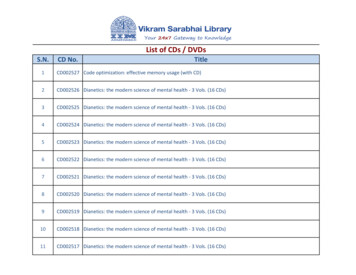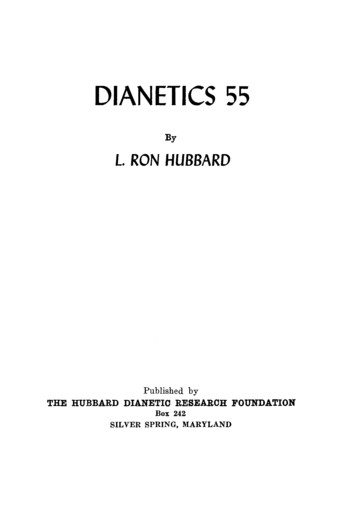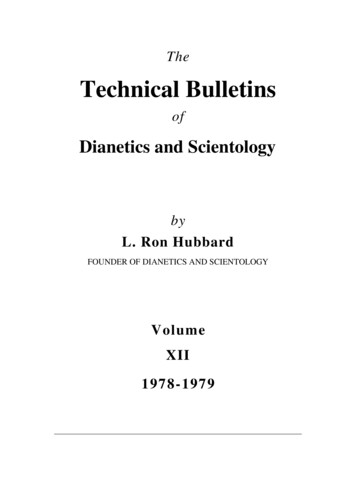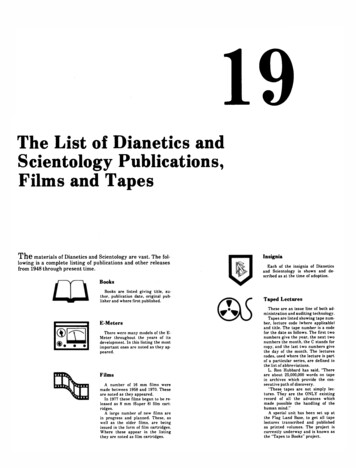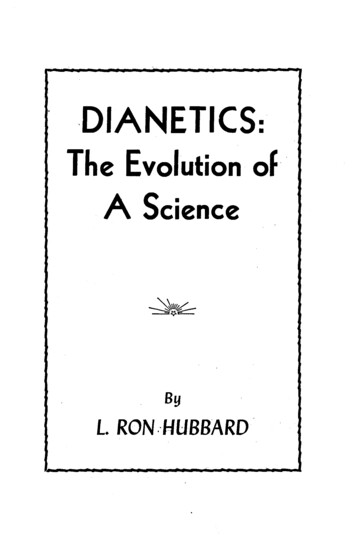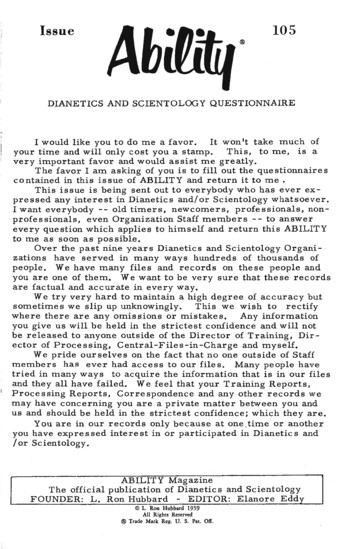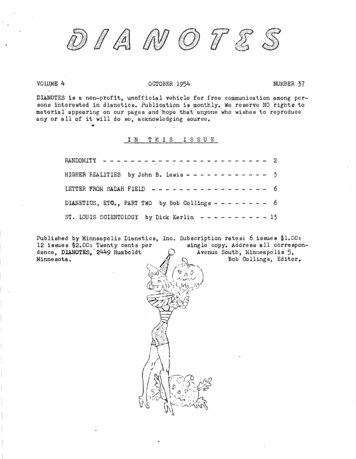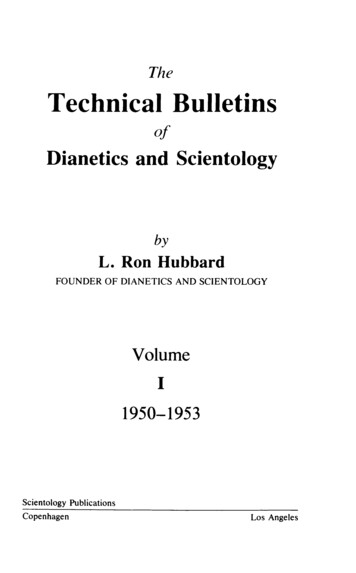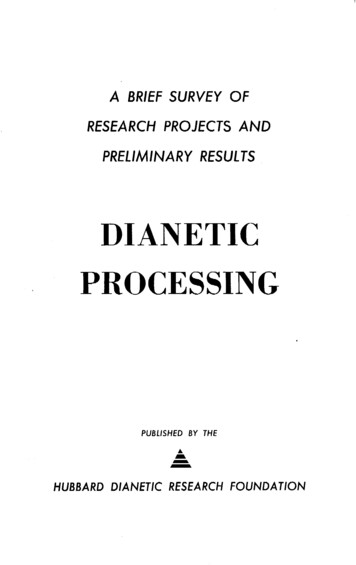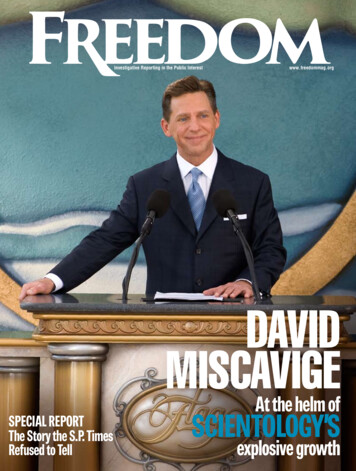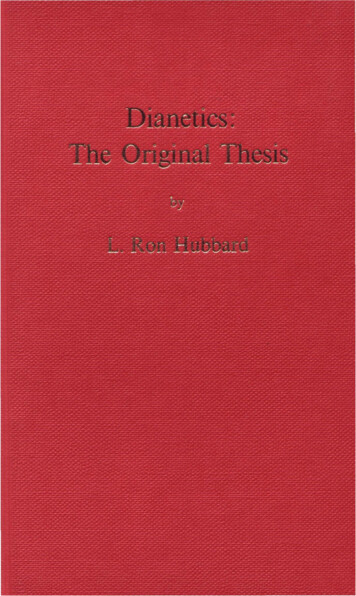
Transcription
DIANETICS:THE ORIGINAL THESISBYL. RON HUBBARDS.P.D. A/S
Published byS.P.O. AjS(Scientology Publications OrganisationA Danish company with limited liability)Toldbodgade 331253 Copenhagen KDenmarkFrom Greek dianoetikos-"through thought" or,"through mind". Term embraces the science of thought andincludes a family of sub-sciences by which the individual andcollective activities of mankind may be understood, predictedand bettered. Dianetic discoveries include the first isolation ofthe single source of human aberration and psychosomatic illsand a technology for their invariable resolution.DIANETICS:Copyright 1951, 1967, 197 0by L. Ron HubbardAll Rights ReservedMade and printed in Great Britain by The Garden City Press Limited,Letchworth, HertfordshireSCIENTOLOGY: From Latin scio, knowing, plus Greek logos,study: "knowing how to know" or, "the study of wisdom".While the field of Dianetics is man and the human mind,Scientology is a religious philosophy and technology addressingthe obtaining of states of existence above that of man; route tototal spiritual recovery and total freedom.Dianetics and Scientology were discovered, developed andorganized by L. Ron Hubbard. Earliest publication, 1948,Dianetics: The Original Thesis.
IMPORTANT NOTEIn studying Dianetics and Scientology be very, very certainyou never go past a word you do not fully understand.The only reason a person gives up a study or becomes confused or unable to learn is that he or she has gone past a wordor phrase that was not understood.Trying to read past a misunderstood word results in mental"fogginess" and difficulty in comprehending the passages whichfollow. If you find yourself experiencing this, return to the lastportion you understood easily, locate the misunderstood wordand get it defined, using a good dictionary or the Glossarystarting on page 147.CONTENTSForewordIntroductionPrimary AxiomsAn Analogy of the MindThe DynamicsThe Basic IndividualEngramsAberra tionsThe Tone ScaleThe Character of EngramsDrama tiza tionThe Auditor's CodeAuditingDiagnosisExhaustion of EngramsEngram ChainsPrenatal, Birth and Infant EngramsThe "Laws" of ReturningCase 117127141147
FOREWORDThis is the first manuscript on Dianetics, writtenquite some time before DIANETICS: The ModernScience of Mental Health. When your editor firstheard that such a manuscript did in actuality exist, hebegged L. Ron Hubbard to let him read it. Hubbarddemurred. He felt that Dianetics had come a long waysince that writing, and that the work would be bettersealed and placed in the Archives, unread.Finally, after much persuasion, Hubbard did permit it to be read. From that day on he was met witha barrage of suggestions to the effect that others wouldenjoy it too, and that it belonged in the library ofevery person who has taken a profound interest inDianetics. Why not publish the manuscript for exactlywhat it is: DIANETICS: «The Original Thesis".True, it may be a far cry from Dianetics as we knowit today, but how fascinating it is to read and pick upfrom its pages the bases for the various modern tech11Iques.And then one day, in a moment of high good humor9
DIANETICS:THE ORIGINAL THESISthat might easily have been tone fourI, Hubbard saidto go ahead and publish it. The manuscript was in thehands of a linotypist within the hour.The reader can easily recognize the extraordinarytask it must have been to evolve the science, and whatwas even more difficult, to communicate it to othersonce its effectiveness was proven.The only editing given this manuscript was that ofchanging some of the words of the original tefIPinology to those in use today; for instance, the wordengram 2 was originally an "impediment". The original continuity of thought has not been altered.This, then, is the original Dianetics. Read it, andenjoy it as much as we have enjoyed it. And may iteven further deepen our respect for the man who hasgiven us the means to be self-determined!THE EDITOR1951tone 4 : the emotional state of enthusiasm.engram: a mental picture of an experience containing pain,unconsciousness and a real or imagined threat to survival.1210INTRODUCTIONIn nineteen thirty-two an investigation was undertaken to determine the dynamic principle of existencein a workable form which might lead to the resolutionof some of the problems of mankind. A long researchin ancient and modern philosophy culminated, innineteen thirty-eight, in the heuristically discoveredprimary law. A work was written at that time whichembraced man and his activities. In the followingyears further research was undertaken in order toprove or disprove the axioms so established.Certain experiences during the war made it necessary for the writer to resolve the work into applicableequations and an intensive program was begun innineteen forty-five toward this end.A year later many techniques had been discoveredOf evolved and a nebulous form of the present workwas formulated. Financed chiefly by a lump sum disability compensation, that form of Dianetics was intensively applied to volunteer subjects, and the workgradually developed to its present form.Dianetics has been under test by the writer, as here11
DIANETICS:THE ORIGINAL THESISdelineated, for the past three years. The last seriesof random volunteers, numbering twenty, were rehabilitated, twenty out of twenty, with an averagenumber of work hours of 151.2 per subject. Dianeticsoffers the first anatomy of the human mind and techniques for handling the hitherto unknown reactivemind, which causes irrational and psychosomatic behavior. It has successfully removed any compulsions,repressions, neuroses and psychoses to which it hasbeen applied.L.R.H.January, 194812PRIMARY AXIOMSDianetics is an heuristic science built upon axioms.\;\T orkability rather than Idealism has been consulted.The only claim made for these axioms is that by theirusc certain definite and predictable results can beobtained.The principal achievement of Dianetics lies in itsorganization. Almost any of its parts can be foundsomewhere in history, even when they were independently evolved by the writer. There are no principal sources, and where a practice or a principle isborrowed from some past school the connection isusually accidental and does not admit any furtheruse or validity of that school. Dianetics will work, andcan only be worked, when regarded and used as aunity. When diluted by broader applications of olderpractices, it will no longer produce results. To avoidconfusion and prevent semantic difficulties, new andsimplified terminology has been used and is used onlyIS defined herein.Dianetics is actually a family of sciences. It ishere addressed in the form of a science of thought13
DIANETlCS:THE ORIGINAL THESISPRIMARY AXIOMSThis can be seen to be the lowest common denominator of the finite universe. It embraces all forms ofnergy. It further delineates the purpose of thatenergy so far as it is now viewable by us in the "knowable" field. The activity of the finite universe caneasily be seen to obey this axiom as though it were acommand. All works and energies can be considered tobe motivated by it. The various kingdoms have this astheir lowest common denominator, for animals, vegetables and minerals are all striving for survival. We donot know to what end we are surviving, and in ourfield of the "knowable" and in our choice of only theworkable axioms, we do not know and have noimmediate reason to ask why.All forms of energy are then surviving to some unknown end, for some unknown purpose. We need onlyto know that they are surviving and that, as units orspecies, they must survive.By derivation from the first workable axiom, wecome into possession of the second. In obedience tothe command "survive", life took on the form of acell which, joining with other cells, formed a colony.The cell, by procreating, expanded the colony. Thecolony, by procreati ?n, formed other colonies. Colonies of different types united and necessity, mutationand natural selection brought about specializing whichincreased the complexity of the colonies until theybecame an aggregation. The problems of the colonialaggregation were those of food, protection and procreation. In various ways a colonial aggregation of1415applicable to psychosomatic ills and individualaberrations.The field of thought may be divided into two areaswhich have been classified as the "knowable" and the"unknowable". Weare here concerned only with the"knowable". In the "unknowable" we place that datawhich we do not need to know in order to solve theproblem of improving or resolving aberrations of thehuman mind. By thus splitting the broad field ofthought, we need not now concern ourselves with suchindefinites as spiritualism, deism, telepathy, clairvoyance, or, for instance, the human soul.Conceiving this split as a line drawn through thearea, we can assign a dynamic principle of existenceto all that data remaining in the "knowable" field.After exhaustive research one word was selectedas embracing the finite universe as a dynamic principle of existence. This word can be used as a guideor a measuring stick and by it can be evaluated muchinformation. It is therefore our first and our controll.mgaxlOm.The first axiom is :SURVIVEl
DIANETICS:THE ORIGINAL THESIScells became a standardized unity and any advancedcolonial aggregation came into possession by necessity,mutation and natural selection of a central controlsystem.The purpose of the colonial aggregation was tosurvive. To do this it had to have food, means of defense, protection and means of procreation. The control center which had developed had as its primarycommand, Survive! Its prime purpose was the food,defense, protection and means of procreation.Thus can be stated the second workable axiom:THE PURPOSE OF THE MIND IS TO SOLVEPROBLEMS RELATING TO SURVIVAL.The ultimate success of the organism, its specie orlife would be, at its unimaginable extreme, immortality. The final failure in obedience to the law survivewould be death. Between eternal survival and deathlie innumerable gradations. In the middle ground ofsuch a scale would be mere existence without hope ofmuch success and without fear of failure. Below thispoint would lie, step by step, innumerable small errors,accidents, losses, each one of which would tend toabbreviate the chances of reaching the ultimate goal.Above this point would lie the small successes, appreciations, and triumphs which would tend to secure thedesirable goal.16PRIMARY AXIOMSAs an axiom, the mind can then be said to act inobedience to a central basic command, survive, andto direct or manage the organism in its efforts toaccompli h the ultimate goal for the individual orspecie or life, and to avoid for the individual or specieor life any part of the final failure, which leads to thestated axiom:THE MIND DIRECTS THE ORGANISM, THESPECIES, ITS SYMBIOTES OR LIFE IN THEEFFORT OF SURVIVAL.A study of the field of evolution will indicate thatsurvival has been, will be, and is the sole test of anorganism, whether the organism is treated in the formof daily activity or the life of the specie. No action ofthe organism will be found to lie without the field ofsurvival, for the organism is acting within its environment upon information received or retarded, anderror or failure does not alter the fact that its basicimpulse was motivated by survival.Another axiom may then be formulated as follows:THE MIND AS THE CENTRAL DIRECTION,,'YSTEM OF THE BODY, POSES, PERCEIVESAND RESOLVES PROBLEMS OF SURVIVALAND DIRECTS OR FAILS TO DIRECT THEIR1:'XECUTION.17
DIANE TICS:THE ORIGINAL THESISPRIMARY AXIOMSAs there are many organisms in the same specie, allattempting to accomplish the same end, and as thereare many species, and as matter itself is attemptingin one unit form or another to survive, there is necessarily conflict and contest amongst the individuals ofthe specie, species, or units of matter. Species cannotsurvive without being interested primarily in thespecies. Natural selection and other causes have established this as a primary rule for survival: That theunit remain alive as long as possible as a unit and, byassociation and procreation, that the specie remainalive as a specie. Second grade interest is paid by theunit or the species to its symbiotes. Third grade interest is paid to inanimate matter. As this is apparentlythe most workable solution, natural selection best preserves those species which follow this working rule.And the symbiotes of the successful specie thereforehave enhanced opportunity for survival.Man is the most successful organism currently inexistence, at least on this planet. Man is currentlywinning in the perpetual cosmic election which possibly may select the thinker of the new THOUGHT.Man is heir to the experience and construction ofhis own ancestors. As cellular conservatism is one ofthe factors of survival, his brain is basically the samebrain which directed and resolved the problems ofhis animal forebears. By evolution and natural selec-The analytical, human or, as it has elsewhere been(;, lied erroneously, the conscious mind, is variablefmll1 individual to individual and race to race in its"iJility to perceive and resolve problems. Another;,,,iom can then be formulated:1819tion, this brain therefore has the primary priority inemergencies. Superimposed on this animal brain hasbeen developed an enormously complex analyzer,which probably exists in his frontal lobe.The command, survive, is variable in individualsand species to the extent that it may be strong orweak. Superior strength of the command in the individual or specie is normally, but variably, a survivalfactor. The primary facet of personality is the basicstrength of the DYNAMIC drive.The DYNAMIC is variable from individual to individual and race to race. It is varied by physiology,environment, and experience. Its manifestation in theanimal brain effects both the tenacity of the individualto life or purpose, and it effects the activity of the;malyzer. The first characteristic of the individualwhich should be considered is the basic strength ofhis DYNAMIC. By this an axiom can be formulated:THE PERSISTENCY OF THE INDIVIDUALIN LIFE IS DIRECTLY GOVERNED BY THE,. . TRENGTH OF HIS BASIC DYNAMIC.
PRIMARY AXIOMSDIANETICS:THE ORIGINAL THESISINTELLIGENCE IS THE ABILITY OF AN INDIVIDUAL GROUP OR RACE TO RESOLVEPROBLEMS RELATING TO SURVIVAL.JJIt should be noted that there is a distinct differencebetween the DYNAMIC and the intelligence. Highintelligence may not denote high DYNAMIC. HighDYNAMIC may not denote high intelligence. Intelligence is mental sensitivity and analytical ability.DYNAMIC is the persistency of the individual inobedience to the command, survive!It has been noted that there is a gradation in thescale of survival. Gains toward the ultimate goal arepleasurable. Failures toward the final defeat aresorrowful or painful. Pleasure is therefore the perception of well-being, or an advance toward the ultimategoal. Pain, therefore, is the perception of a reductiontoward the final defeat. Both are necessary survivalfactors.For the purpose of Dianetics, good and evil mustbe defined. Those things which may be classified asgood by an individual are only those things whichaid himself, his family, his group, his race, mankindor life in its dynamic obedience to the command,modified by the observations of the individual, hisfamily, his group, his race, or life.As evil may be classified those things which tend20to limit the dynamic thrust of the individual, hisfamily, his group, his race, or life in general in thedynamic drive, also limited by the observation, theobserver and his ability to observe.Good may be defined as constructive. Evil may bedefined as destructive-definitions modified by viewpoint. The individual man is an organism attemptingto survive in affinity or contest with other men, races,and the three kingdoms. His goal is survival for himself, his progeny, his group, his race, his symbiotes,I ife and the universe in general in contest with anyefforts or entities which threaten or impede his effortsto attain the goal.His happiness depends upon making, consolidating,or contemplating gains toward his goal.I t is a purpose of Dianetics to pass man across theabyss of irrational, solely reactive thought and enterhim upon a new stage of constructive progression tothe ultimate goal.21
AN ANALOGY OF THE MINDAN ANALOGY OF THE MINDhowever from the axioms cursorily touched upon inthe last chapter and is uniformly governed by theprinciples of the behavior of the human mind.When an individual is acting contrary to survivalof himself, his group, progeny, race, mankind, or lifehe can be considered to be unintelligent, uninformed()r aberrated. Every single instance of aberrated conduct threatening the general goal of the individual asoutlined in the last chapter can be proven to have asource which will specifically be found to be a painful(,xperience containing data not available to the ana/rtical mind. Every single instance and facet of aberLlted conduct has its exact causation in the physicallypainful error which has been introduced during alIIoment of absence of the analytical power.Dianetics consists of discovering the aberration int he individual, finding the physically painful experience which corresponds to it and placing the datat herein contained at the disposal of the analyticalIllind.I t is not the purpose of Dianetics to reconstruct thehuman mind. The purpose of Dianetics is to deletefrom the existing mind those physically painful experiences which have resulted in the aberration of theanalytical mind, to resolve the physical manifestationsof mental aberration, and to restore in its entirety theproper working function of a brain not otherwisephysically deranged.Dianetics thus embraces the various aspects ofpsychosomatic conditions, including the glandularbalance or imbalance of the organism, as influencedby painful physical experience. However, its purposeis not one of healing, and its address is not to suchpsychosomatic manifestations specifically, but ratherto those aberrative experiences in which these conditions have their roots.The initial adjustments of the individual are included in Child Dianetics and Educational Dianetics.Judical Dianetics, Political Dianetics and MilitaryDianetics are elsewhere touched upon or allocated forstudy. Dianetics, as a family of sciences, proceedsMore as an effort to demonstrate how that is accomplished than as an actual outline of the character oft he mind, the following analogy is offered.First there is the physio-animal section of the brain,mntaining the motor controls, the sub-brains, and thephysical nervous system in general, including thephysical aspect of the analytical section of the braIn.2223
DIANETICS:THE ORIGINAL THESISAN ANALOGY OF THE MINDThe control of all voluntary and involuntary musclesis contained in this section. It commands all bodyfluids, blood flow, respiration, glandular secretion,cellular construction, and the activity of various partsof the body. Experimentation has adequately demonstra ted this. The physio-animal mind has specificmethods of "thinking". These are entirely reactive.Animal experimentation-rats, dogs, etc.-is experimentation on and with precisely this mind and littlemore. It is a fully conscious mind and should neverbe denoted by any term which denies it "consciousness" since there is no period in the life of the organismfrom conception to death when this mind is not awake,observing, and recording perceptics. This is the mindof a dog, cat, or rat and is also the basic mind of aman so far as its operating characteristics are concerned. A man in the deepest possible somnambulisticsleep is still in possession of more mind and thinkingand coordinating ability than a lower animal.The term "consciousness" is no more than a designation of the awareness of now. The physio-animalmind never ceases to be aware of now and never ceasesto record the successive instances of now which in theircomposite make up a time track connecting memoryin an orderly chain.Cessation of life alone discontinues the recordingof perceptions on this orderly track. Unconsciousnessis a condition wherein the organism is discoordinated(mly in its analytical process and motor control direct ion. In the physio-animal section of the brain, a(·ornplete time track and a complete memory record()f all perceptions for all moments of the organism's('xistence is available.As life progresses, for instance, from a blade of rass, greater and greater complexities and degrees of.' elf -determinism are possible. Energy in its variousforms is the primary motivator in the lower orders, butas the complexity of the order is increased into theanimal kingdom, the physio-animal brain attainsmore and more command of the entire organism untilit itself begins to possess the second section of themind.All animals possess in some slight degree an analyzer. This, which we designate the analytical mind,is present even in lower orders, since it is only thatsection of the brain which possesses the self-deterministic coordinative command of the physio-animalbrain and thus of the body. In a rat, for instance, itis no more than its "conscious" awareness of now;tpplying to lessons of then without rationality butwith instinct and painful experience. This is the anal ytical section of the mind in a lower animal but iti., the reactive mind in a man whose analytical mind2425
DIANETICS:THE ORIGINAL THESISAN ANALOGY OF THE MINDis so highly attuned and intricate that it can commandentirely the physio-animal brain and thus the body.Man not only possesses a superior physio-animalmind but possesses as well an analytical mind of suchpower and complexity that it has no real rival in anyother species. The analytical mind of man cannot bestudied by observing the reactions of animals underany situations. Not only is it more sensitive but itpossesses factors and sensitivities not elsewhere found.Continuing this analogy: Lying between the analytical mind and the physio-animal mind may beconceived the reactive mind. This is the coordinatedresponses of the physio-animal mind, the "analytical"mind of animals, and the first post of emergency command in man. All errors of a psychic or psychosomaticnature can be considered for the purposes of thisanalogy to lie in the reactive mind. The first humananalytical mind took command of the body andphysio-animal mind under strained and dangerouscircumstances when man was still in violent contestwith other species around him. It can be consideredthat the analytical mind received command with thesingle proviso that instantaneous emergency wouldbe handled by the outdated but faster reactive mind.Any and all errors in thinking and action derivefrom the reactive mind as it is increased in strengthand power by painful experience. It can be called ashadow mind, instantaneously reactive when any ofits content is perceived in the environment of the individual, at which time it urgently bypasses the analytical mind and causes immediate reaction in thephysio-animal mind and in the body. Additionally,the reactive mind is in continual presence whenchronically restimulated by a constantly present restimulator-which is to say, an approximation of thereactive mind's content or some part thereof continually perceived in the environment of the organism.The reactive mind is in action so long as it is activatedby an exact or nearly exact approximation of its content. But given too continuous a restimulation, it canand does derange both the physio-animal mind andbody below it and the analytical mind above it. It wascreated by deranging circumstances of a physicalnature, hence it deranges.The entire content of the reactive mind is recordsof physical pain with its accompanying perceptionsduring disconnection of the analyzer. All aberratedconduct and error on the part of an individual is()ccasioned by restimulation of his reactive mind.None of these minds are "unconscious", nor arethey subconscious. The entire organism is alwaysconscious but the temporary dispersion of thethought processes of the analytical mind brings abouta condition whereby that mind, having been dis-2627,
DIANETICS:THE ORIGINAL THESISpersed and considering itself the residence of theperson, is unable to obtain and reach data perceivedand received by the organism during the analyticalmind's condition of dispersion. That the analyticalmind can be thrown, by pain or shock, out of circuit is a survival factor of its own: as sensitive"machinery" it must be protected by a fuse system.28THE DYNAMICSThe basic dynamic, SURVIVE, increases in complexity as the complexity of the organism evolves.Energy may be considered to have taken many pathsthrough eternity to arrive intact at the infinite goal.The "why" of the goal may lie above the finite line butIJClow it, demarked by the word SURVIVE, definitemanifestations are visible. Energy collects into variousforms of matter which collect and aggrega te in variouslllaterials and compounds. Life evolves from the irnplest basic into complex forms since evolutionary(. hange is in itself a method of survival.Conflict amongst species and individuals within the. pccies is additionally a survival factor. Affinity of in(Ii viduals for groups, races, and the whole of its speoies,.Illel for other species, is additionally a survival factor,; I S strong or stronger than conflict.Drive is defined as the dynamic thrust through timetoward the attainment of the goal. Survive is con idcred to be the lowest common denominator of all('llcrgy efforts and all forms. It can then be sub-divided\pccifically into several drive lines as applicable to29
DIANETICS:THE ORIGINAL THESISeach form or species. The unaberrated self containseight main drives which are held in common withman.The dynamics are: One, self; Two, sex; Three,group; Four, mankind; Five, life; Six, the physicaluniverse; Seven, thought; Eight, universal thought orinfinity.An entire philosophy can be built around each oneof these dynamics which will account for all theactions of an individual. Anyone of these philosophiesis so complete that it can be logically made to includethe other seven. In other words, all purpose of anindividual can be rationalized into the dynamic of self.A philosophy exists which attempts to rationalizeeverything into the sexual dynamic, and so on with allthe dynamics. Observing that each one can stand asa logical unity, one finds it necessary to retire to thelowest common denominator of the basic dynamicwhich actually does explain the eight subdivisions. Aseach one of the subdivisions is capable of supportingthe whole weight of a rational argument, it can readilybe deduced that each is of nearly equal importance inthe individual. The aberrated conditions of a societytend to vary the stress on these dynamics, making firstone and then another the keynote of the society.In an unaberrated individual or society, the validityof all eight would be recognized.30THE DYNAMICSThe unaberrated individual may physiologicallypossess or environmentally stress one or more of thesedynamics above the others. In terms of basic persond I ity,the physiological-environmental-educa tiona Idspect of the individual is of varied strength in theeight dynamics.Each one of the eight dynamics breaks further intopurposes which are specific and complex. Purposes;lIld other factors entangle these dynamics, and varying situations and the observational power of the individual may conflict one of these dynamics againstdllother within the individual himself. This is a basic('( nnplex factor of unaberrated personality.I. THE DYNAMIC OF SELF consists of the dyflamic thrust to survive as an individual, to obtainpleasure as an individual, and to avoid pain. It coverst he general field of food, clothing and shelter, pers()nal ambition, and general individual purpose.II. THE DYNAMICS OF SEX embraces the pro«'cation of progeny, the care of that progeny, and thes(Turing for that progeny of better survival conditions;lIld abilities in the future.Ill. THE DYNAMIC OF GROUP embraces the\';lrious units of the specie, such as the association, theIllilitary company, the people in the surrounding(ountryside, the nation and the race. It is characterifnI by activity on the part of the individual to obtain31
DlANETICS:THE ORIGINAL THESISand maintain the survival of the group of which he isa part.IV. THE MANKIND DYNAMIC embraces thesurvival of the species.V. THE DYNAMIC OF LIFE is the urge of theindividual to survive for life and for life to survive foritself.VI. THE PHYSICAL UNIVERSE DYNAMICis the drive of the individual to enhance the survivalof all matter, energy, time and space.VII. THE THOUGHT DYNAMIC concerns theurge of the individual to survive as thought.VIII. THE DYNAMIC OF UNIVERSALTHOUGHT is the urge of the individual to survivefor the Creator.While man is concerned with anyone of the abovedynamics, anyone of them may become antipatheticto his own survival. This is rational conflict and is normally and commonly incidental to survival. It is nonaberrative in that it is rational within the educationallimitation.The family as a unit is not a dynamic but a combination of dynamics. And in this and other societiesTHE DYNAMICSit attains a position of interest which is not necessarilyinherent in the individual or group.Basically simple, complexity is introduced amongstt he dynamics by individual and group irrationalities.'['he basic (unaberrated) individual has continual diffindty rationalizing the problems of importances andchoices amongst these dynamics. When the basic individual becomes aberrated and is attendantly unable to reason freely on all problems, a selection ofimportances amongst these dynamics becomes earlyirnpossible and produces aberrated solutions whichlllay resolve such an extreme as the destruction of thein
This is the first manuscript on Dianetics, written quite some time before DIANETICS: The Modern Science of Mental Health. When your editor first heard that such a manuscript did in actuality exist, he begged L. Ron Hubbard to let him read it. Hubbard demurred. He
